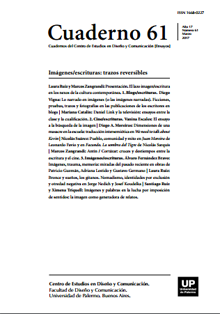Imágenes y palabras en la lucha por imposición de sentidos: la imagen como generadora de relatos
Abstract
It is well known the trajectory proposed by Philippe Dubois of Peirce’s second trichotomy –icon, index and symbol– to analyze the relationship that have historically been established between photography and “reality”: the image as an icon (“mirror” of the world); the image as a symbol (subjected to conventions); the image as an index (“trace” of reality). It is evident that this sequence does not propose a progression but, rather, a possible reading of the visual sign. As a result, icon, index, and symbol, far from referring to a type, constitute ways in which these signs function or are read. However, an inescapable fact is that, from the point of view of reception, in comparison with spoken o written language, images propose a less mediated relationship with a “real” referent and therefore –this is our hypothesis– possess greater efficiency in the fight for the imposition of meanings. Thus, if discourses in general “build reality”, visual representations assume within these a particular efficiency so far as they confront us with the strength of evidence (the exact copy or footprint of the real).
References
Batchen, G. (2004). Arder en deseos. La concepción de la fotografía. Barcelona: Gustavo Gili.
Barthes, R. (1974). “El mensaje fotográfico” y “Retórica de la imagen” en AA.VV. La Semiología. Serie Comunicaciones. Buenos Aires: Tiempo Contemporáneo.
__________. (1989). La cámara lúcida. Nota sobre la fotografía. Barcelona: Paidós.
Dalmasso, M. T. (1994). ¿Qué imagen? ¿De qué mundo? Córdoba: Dirección General de Publicaciones. Universidad Nacional de Córdoba.
Deledalle, G. (1996). Leer a Peirce hoy. Barcelona: Gedisa.
Dubois, P. (1986). El acto fotográfico. De la representación a la recepción. Barcelona: Paidós.
Eco, U. (1982). “Semiología de los mensajes visuales” (1968) en AA.VV. Análisis de las imágenes. Serie Comunicaciones. Barcelona: Ediciones Buenos Aires.
Foucault, M. (1987). El orden del discurso. Barcelona: Tusquets.
Ong, W. J. (1996). Oralidad y escritura. Buenos Aires: FCE.
Peirce, Ch. (1931). Collected Papers. Vol. I. Principles of Philosophy. Cambridge: Harvard University Press.
__________. (1932). Collected Papers. Vol. II. Elements of Logic. Cambridge: Harvard University Press.
__________. (1987). Obra lógico-semiótica. Madrid: Taurus.
__________. (1988). El hombre, un signo (El pragmatismo de Peirce). Barcelona: Crítica.
Ruiz, S. y Triquell, X. (junio 2010). “El estatuto semiótico de las imágenes”. Pensares revista del CIFFyH, 6, 137-148.
Verón, E. (noviembre 1978) “Discurso del poder, poder del discurso”. En Anais do primero coloquio de Semiótica, Loyola e Pontificia Universidade Católica do Rio de Janeiro, 85-97.
__________. (1980) “La semiosis social”. En Monforte Toledo (ed.). El discurso político. México: Nueva Visión.
__________. (1996) La semiosis social. Buenos Aires: Gedisa.
Los autores/as que publiquen en esta revista ceden los derechos de autor y de publicación a "Cuadernos del Centro de Estudios de Diseño y Comunicación", Aceptando el registro de su trabajo bajo una licencia de atribución de Creative Commons, que permite a terceros utilizar lo publicado siempre que de el crédito pertinente a los autores y a esta revista.


